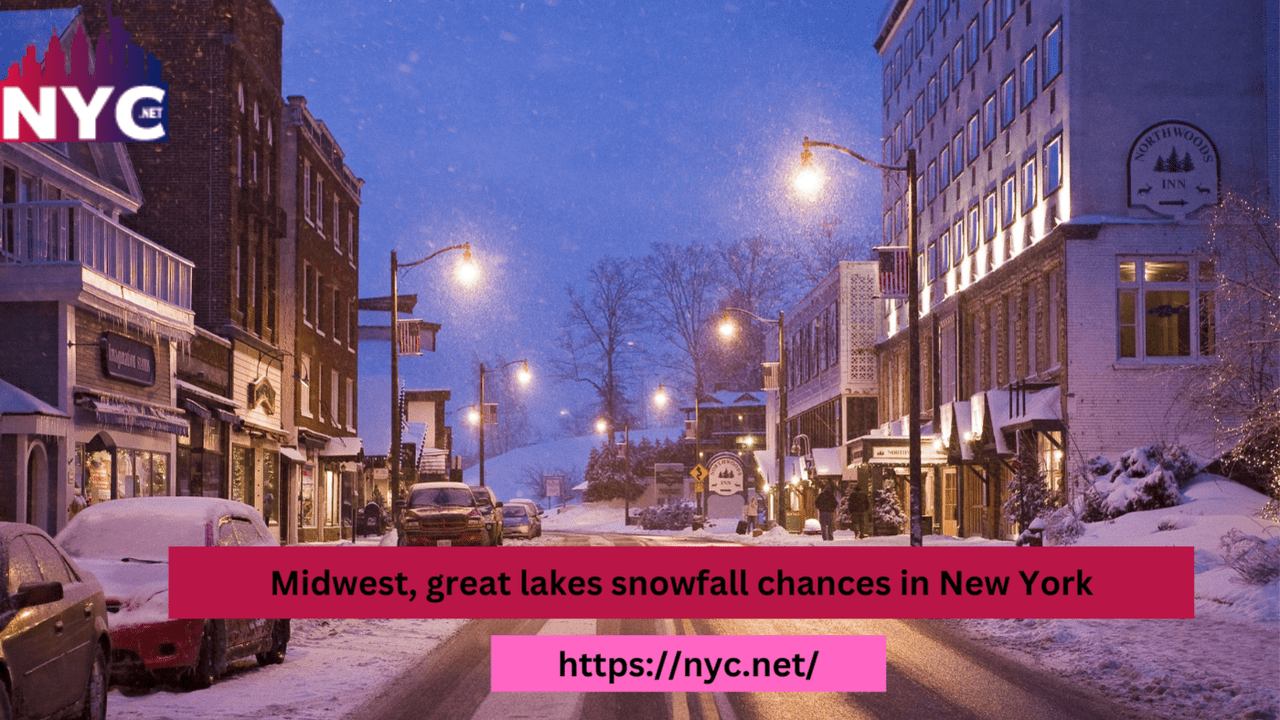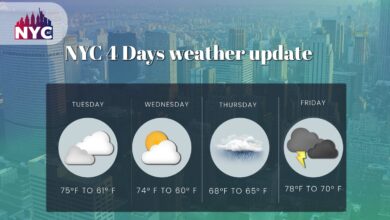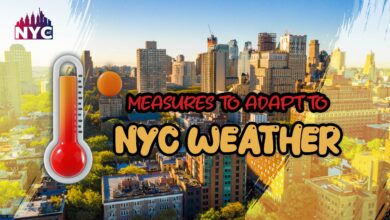Midwest, great lakes snowfall chances in New York

Even if the first day of winter may not arrive for another couple of weeks, it may start to feel and appear that way by the end of this week. According to AccuWeather meteorologists, chilly and stormy weather might continue to impede holiday shopping and outdoor festivities in the days ahead.
The week began with nearly seasonal conditions, with afternoon high temperatures on Monday holding within a few degrees of average in cities from Buffalo, New York, to Philadelphia. Conditions are anticipated to gradually warm up until the middle of the week before the colder air arrives behind the front.
What is lake-effect snow?
The Great Lakes area frequently experiences lake-effect snow in the late fall and winter. It happens when chilly air travels over the Great Lakes’ open water, usually from Canada.
Warmth and moisture are carried into the lowest part of the atmosphere as the cold air travels over the Great Lakes’ warmer waters. In narrow bands that generate two to three inches of snow per hour or more, clouds develop as the air rises. What places may see lake-effect snow depends in part on the direction of the wind. The air may contain more water if the wind is blowing in a direction that covers more of the lake.
Also, the bigger the temperature difference between the lake and the air, the more water the air is able to hold.
Seasonal Predictions n Different Locations:
The sun may be beaming just a mile or two away in either direction, while heavy snowfall may be occurring in one area, depending on the direction of the wind.
With afternoon high temperatures on Monday hovering within a few degrees of average in locations from Buffalo, New York, to Philadelphia, the week began with nearly seasonal conditions. Conditions are anticipated to gradually warm up through the middle of the week before the colder air arrives behind the front. Cooler air will sweep in during this period and hold over the northern Plains and portions of the Great Lakes. For the first part of the week, Minneapolis’ high temperatures will be in the 20s, while Madison, Wisconsin, will see the 30s through Wednesday.
Ohio Valley in NewYork:
Another storm is expected to move from the central Plains towards the Ohio Valley and the Northeast as the second half of the week approaches, but its precise path will decide how it affects the northern part of the country.
As it moves through the Plains on Thursday, this storm is expected to get stronger. In certain areas of Missouri, Illinois, Indiana, Kentucky, and Tennessee, widespread rain is expected during the day. This will bring yet another bout of rain, which might increase the risk of flooding, to more southern areas like the Tennessee River Valley.
How much Snow Could Accumulate?
Another storm is expected to move from the central Plains towards the Ohio Valley and the Northeast as the second half of the week approaches, but its precise path will decide how it affects the northern part of the country.
As it moves through the Plains on Thursday, this storm is expected to get stronger. In certain areas of Missouri, Illinois, Indiana, Kentucky, and Tennessee, widespread rain is expected during the day. This will bring yet another bout of rain, which might increase the risk of flooding, to more southern areas like the Tennessee River Valley.
Storms Shift
As the storm moves to the east on Thursday night and Friday, the amount of snowfall becomes increasingly unpredictable.
Temperatures in the (coastal) Northeast may be too warm for much snow, according to AccuWeather Senior Meteorologist Dan Pydynowski. This depends on the storm’s path and how far south the cold air travels.
In the northeastern United States, where the air is most likely to be the coldest, snow is most likely to fall farther north, close to the Canadian border. The storm might, however, make landfall in the central Atlantic. The moisture in this scenario will be well south of the subfreezing temperatures, keeping northern New York and northern New England frigid but dry. Rain then started to pour in cities like Pittsburgh, and Hartford, Connecticut.
Parts of Maryland, New Jersey, southern New York, and southern New England may get snowfall if the stronger, colder air sinks into the Northeast and the storm moves through the mid-Atlantic.
Even if it doesn’t snow in these places, snow enthusiasts need not worry. In the middle of the month, there might be additional rain and chances for snow.
ACCUWEATHER PREDICTION
AccuWeather predicts a “triple dip La Nia,” a climatic phenomenon that happens when the water around the equatorial Pacific Ocean is colder than typical and affects worldwide weather patterns, would likely result in less snowfall in New York than usual this year.
While Staten Island is experiencing early blasts of chilly air well before winter officially begins, AccuWeather experts anticipate a much warmer start to the winter season later this year.
According to AccuWeather, the strongest blasts of cold air won’t arrive until later in the winter. “Residents in the Northeast and Midwest may see a few winter previews in November and December when waves of cold air drop down from Canada,” it stated.
Above-average winter temperatures can allow moisture to be stored in the sky and lead to strong future precipitation, just as warmer summer temperatures function as fuel for storms to dump considerable amounts of rain.
Thus, barely above-normal but below-freezing temperatures might contribute to the formation of large storms.
How warm the Great Lakes Influence Lake-Effect Snow season in Upstate NY?
NY’s Syracuse – The Great Lakes basked in almost record-breaking temperatures this summer and fall, just like the rest of us. That indicates that the lakes are substantially warmer this time of year than usual. Does that imply a spectacular lake-effect snow season in Upstate New York?
Although somewhat warm lake water is a necessary component in the creation of lake-effect snow, it is insufficient on its own. It needs cold air that is blowing over the lakes in the ideal direction to create lake-effect snow. Mark Wysocki, a climatologist for the state of New York, stated, “you still need to have the appropriate type of pattern.”
By forcing cold air from Canada toward the east and southeast, the proper lake effect snow pattern evaporates water from lakes and deposits it as snow on the ground.
The majority of the lake effect snow in Central New York comes from Lake Ontario. The water was 4 degrees warmer on Monday than it typically is. On November 8, 2016, Ontario reached a temperature that was a quarter of a degree higher than it is right now.
West New York and Tug Hill Plateau snow season analysis
Lake effect snow season in Upstate has already started: Last week, when a rather cold airburst passed over Lake Erie and Lake Ontario, parts of Western New York and the Tug Hill plateau received a few inches of precipitation. However, the air has been too warm thus far to produce any significant lake-effect snow.
Meteorologist Suggestions
Paul Pasteli, a senior meteorologist with Accuweather, suggested that may soon alter. He said it looks like early next week and perhaps next weekend, hold the key ingredients to produce some snow that could stick to the ground on the traditional lake effect belts. That includes parts of Central New York.
“We’re getting some colder air here in November, and there will be some lake effect,” he said.
He predicted that somewhere in Central New York, several inches of lake effect snow might fall early next week. The weather service concurs, predicting bands of lake effect snow on Monday into Tuesday due to a passage of cold air from the northwest.
According to the meteorological service’s Binghamton office, which issues predictions for Central New York and the Finger Lakes, “We will not have a solid sense until much closer to that time frame, but some accumulating snow is possible for the regions that end up getting touched.”
Because bands of snow might be just a few miles broad and can fluctuate rapidly with minute changes in wind direction, lake effect snow is famously difficult to anticipate. Tug Hill may be battered by winds coming from the west as they travel the length of Lake Ontario. Syracuse comes into focus if the wind direction changes to the northwest.
Frequently Asked Questions
1- Will New York have a lot of snow this year?
This winter in NYC, a near-normal temperature profile is anticipated, with colder risks early and warmer risks later in the season. For the winter months, precipitation is expected to fall at a rate above average. Average snowfall is predicted to be a little bit more than usual.
2 NYC 2022: Will there be snow?
On November 17, 2022, snow falls in Ellicottville, New York. Why does snow have a lake effect? The National Weather Service Eastern Region said that 80 inches of snow fell in neighboring Orchard Park between Thursday and Sunday afternoon, making it the third-highest three-day total in New York history.



